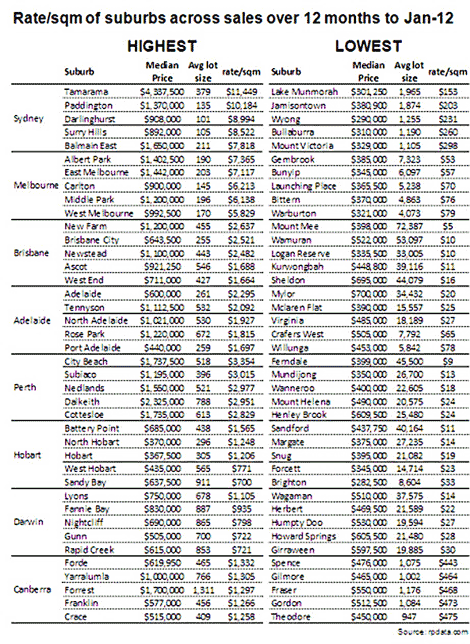Buyers pay a high premium for every square metre of inner-city living: Cameron Kusher
Across each capital city housing market there is a significant gap between those houses that have the lowest rate per square metre and those that have the highest.
All figures quoted in this report are based on median sale prices over the 12 months to January 2012 and the average lot size of those properties that have sold. Although the analysis doesn't take into account qualitative factors such as the quality or size of the home, views, state of repair or other factors, the analysis provides a simple proxy for the premiums being paid for housing in certain areas.
Generally it is the inner-city suburbs within each capital city that have recorded the highest average rate/sqm over the past year. Not only are these suburbs characterised as being close to the city centre, they have also recorded a subsequent high median selling price and tend to have a fairly small average lot size. As a result of these conditions the rate/sqm is highest in these inner city areas and representative of the premium residents will pay to purchase in these regions even if it means they are acquiring a relatively small lot.
Focusing on those suburbs with the cheapest rate/sqm within the capital cities, it is typically acreage areas and/or those on the outskirts of the city that have made the list. Not only are these suburbs further away from the city but their acreage nature means that demand is typically lower for these properties. It is also important to note that often houses in these areas are not linked to town water and sewerage.
The table below details the five most expensive and five most affordable suburbs on a rate/sqm basis across each capital city.
Click to enlargeThe beachside suburb of Tamarama in Sydney recorded the highest rate/sqm ($11,449/sqm) based on a median house price of $4,337,500 and an average lot size of 379 sqm over the past year. Tamarama has a relatively limited supply of houses and the fact that many have ocean views has resulted in the high median prices. In recent years the area has also seen the introduction of a lot more small lot housing which has contributed to the higher rates/sqm.
In fact, the five most expensive suburbs on a rate/sqm basis in Sydney were more expensive than any other suburbs across the other capital cities capital cities.
Sydney and Melbourne were the only two cities to have suburbs with an average rate/sqm of more than $5,000. Across Sydney, 26 suburbs had a rate/sqm in excess of $5,000 and in Melbourne seven suburbs did. Not surprisingly, all of these suburbs with a rate/sqm in excess of $5,000 were located relatively close to the city centre and many had a relatively small average lot size.
With a median house price of $398,000 and an average lot size of 72,387 square metres, Mt Mee in Brisbane had the lowest rate/sqm at just $5/sqm. Although the suburb is undoubtedly desirable, it is located 47 kilometres away from Brisbane and has very little local amenity. The large average lot size of 72,387 square metres also contributes to the low rate/sqm. Overall the evident trends are to be expected, residents pay a significant premium to be located close to the city centre and this is reflected by the fact that those suburbs close to the CBD have a much higher rate/sqm compared to those situated further away. Acreage properties on the outskirts of the city on the other hand may have a relatively high median sale price however, the large lot sizes result in a fairly low rate/sqm.
As inner-city areas continue to undergo densification we would expect that the rate/sqm in these suburbs will continue to increase. The reason being that not only is demand likely to remain strong and possibly increase for inner-city properties but also as many homes get knocked down and replaced by higher density construction, there will be fewer opportunities to purchase houses in these areas. As a result, the prices paid for these homes is likely to be higher as the supply of these homes is actually lower than it has been historically.
This article originally appeared on SmartCompany.
Cameron Kusher is senior data analyst at RP Data.
